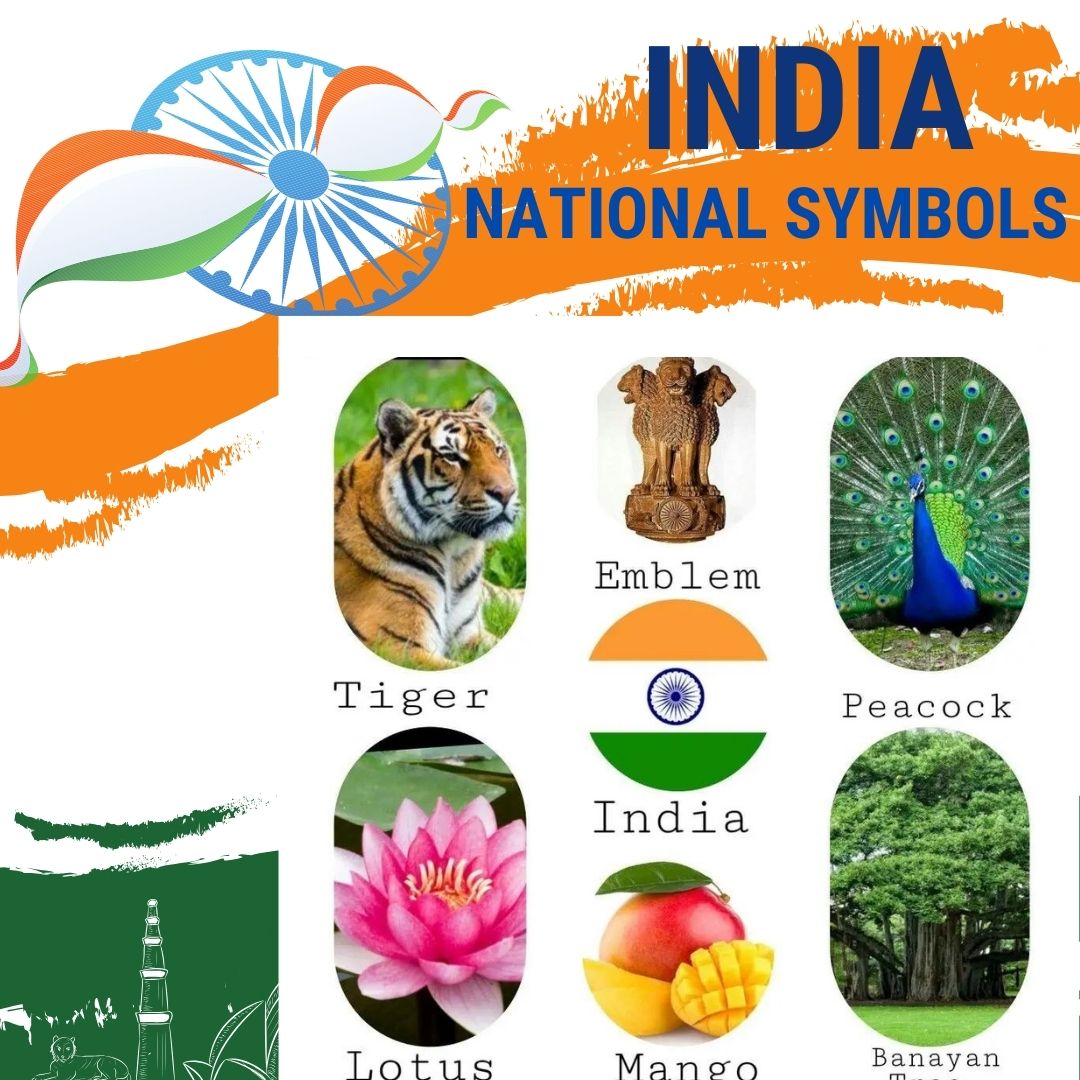Introduction
National symbols are the pride of any nation, representing its rich heritage, cultural diversity, and historical significance. In this post, we will explore the national symbols of India, each carrying a unique story and significance.
National Flag: The Tricolor (Tiranga)
Description
The National Flag of India is a horizontal tricolor of deep saffron at the top, white in the middle, and dark green at the bottom in equal proportions. In the center of the white band is a navy blue wheel with 24 spokes, known as the Ashoka Chakra.
Historical Significance
The design of the flag was adopted on 22 July 1947. The saffron color represents courage and sacrifice, white stands for peace and truth, and green symbolizes faith and chivalry. The Ashoka Chakra represents the eternal wheel of law.

National Emblem: The Lion Capital of Ashoka
Description
The National Emblem of India is an adaptation of the Lion Capital of Ashoka at Sarnath. It features four Asiatic lions standing back to back, but only three are visible in the two-dimensional representation.
Historical Significance
Adopted on 26 January 1950, the emblem symbolizes power, courage, confidence, and faith. Below the lions, there is a horse and a bull, and in the center is a Dharma Chakra (wheel of law).
National Anthem: Jana Gana Mana
Description
The National Anthem of India, “Jana Gana Mana,” composed by Rabindranath Tagore. It was first sung on 27 December 1911 at the Calcutta Session of the Indian National Congress.
Historical Significance
Adopted on 24 January 1950, the anthem is a hymn to the land of India and its varied cultural heritage.
Indian Constitution an Overview
National Song: Vande Mataram
Description
“Vande Mataram,” composed by Bankim Chandra Chatterjee, is considered the National Song of India. It was first sung in 1896 by Rabindranath Tagore.
Historical Significance
The song played a vital role in the Indian independence movement, inspiring the freedom fighters.
National Animal: The Bengal Tiger
Description
The Bengal Tiger (Panthera tigris tigris) is the national animal of India. It is known for its power, strength, and grace.
Significance
The Bengal Tiger symbolizes India’s wildlife wealth and is a part of India’s identity. Efforts are ongoing to conserve this magnificent species.
National Bird: The Indian Peafowl (Peacock)
Description
The Indian Peafowl (Pavo cristatus), commonly known as the peacock, is the national bird of India. It is known for its vibrant plumage and graceful dance.
Significance
The peacock symbolizes beauty, grace, and elegance. It holds a special place in Indian art and culture.
National Flower: The Lotus
Description
The Lotus (Nelumbo nucifera) is the national flower of India. It is a sacred flower and occupies a unique position in Indian culture.
Significance
The lotus symbolizes purity, beauty, wealth, and enlightenment. It is often associated with Hindu gods and goddesses.
National Tree: The Banyan Tree
Description
The Banyan Tree (Ficus benghalensis) is the national tree of India. It is known for its large structure and longevity.
Significance
The banyan tree represents eternal life due to its ever-expanding branches. It is also considered sacred in many cultures across India.

National Fruit: The Mango
Description
The Mango (Mangifera indica) is the national fruit of India. People loved for its delicious taste and nutritional value.
Significance
Mangoes have been cultivated in India for thousands of years and are deeply embedded in Indian traditions and cuisine.
National River: The Ganges
Description
The Ganges (Ganga) is the national river of India. It considered the most sacred river by Hindus.
Significance
The Ganges holds great religious significance and is vital for the agriculture and livelihood of millions of Indians.
National Aquatic Animal: The Ganges River Dolphin
Description
The Ganges River Dolphin (Platanista gangetica) is the national aquatic animal of India. This Dolphin found in the Ganges and Brahmaputra rivers and their tributaries.
Significance
The river dolphin is a symbol of the health of the river ecosystem. Conservation efforts are ongoing to protect this endangered species.
National Currency Symbol: The Indian Rupee (₹)
Description
The Indian Rupee (₹) is the official currency symbol of India. The indian rupee adopted in 2010 and is derived from the Devanagari consonant “र” (ra).
Significance
The symbol represents the Indian economy and its growing influence in the global market.
National Calendar: The Saka Calendar
Description
The Saka calendar is the national calendar of India, officially adopted on 22 March 1957. It starts from the month of Chaitra (March-April) and has a normal year of 365 days.
Significance
The Saka calendar used alongside the Gregorian calendar for official purposes and represents India’s historical time-keeping traditions.
National Game: Field Hockey
Description
Field Hockey often considered the national game of India. India has a rich history in field hockey, winning numerous Olympic medals.
Significance
Field Hockey symbolizes India’s sporting excellence and has been a source of national pride for decades.





